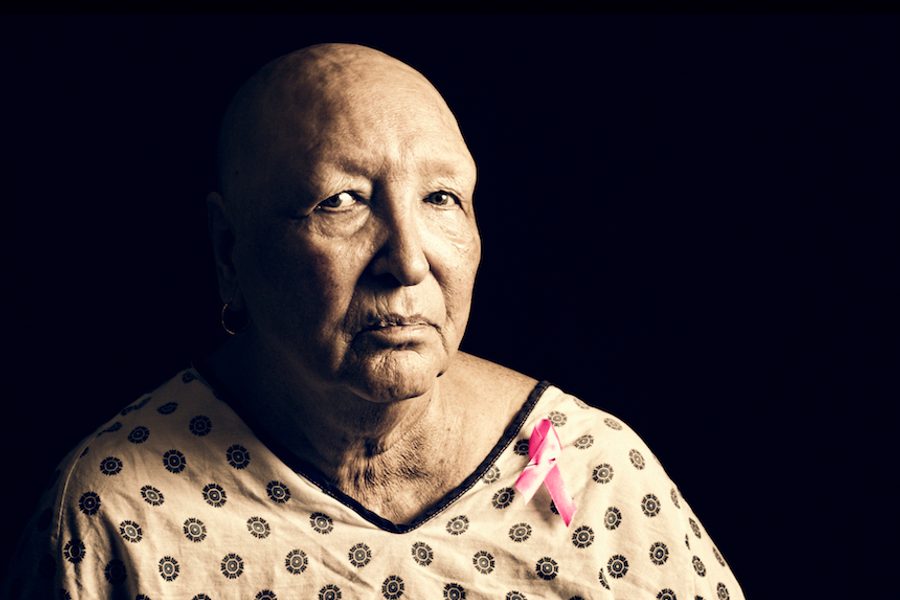Seeing Red about Thinking Pink
The “pink” slogan behind National breast Cancer Awareness Month has become consumer-oriented and emphasizes an individualistic approach to healthcare.
Lucinda Marshall

Along with the traditional browns and tans of falling leaves and Thanksgiving turkeys, each autumn’s colorscape now includes a jarring bubblegum pink. October marked the 24th year of National Breast Cancer Awareness Month (NBCAM), which is sponsored by the AstraZeneca HealthCare Foundation along with numerous other organizations, medical associations and government agencies.
Breast cancer is the poster child for cause marketing: There is no other disease we try to eradicate by going shopping. Too often, however, the solution and the problem are commingled.
Who can resist pink M&M’s or Oreo cookies with little pink ribbons, for example? Never mind that junk food makes our bodies more vulnerable to disease. Estée Lauder donates money from the sale of its Elizabeth Pink lipstick; unfortunately it contains parabens, a chemical class that has long been linked to breast cancer. BMW will make a donation to the Susan G. Komen Foundation when you test-drive one of their vehicles and Ford Motor Company donates the proceeds from its Warriors in Pink line of clothing to Komen, an organization that supports breast cancer research and community outreach programs such as the Race for the Cure. The vehicles of both companies, however, continue to spew out carcinogen-laden exhaust. These examples and more are detailed online at www.thinkbeforeyoupink.org.
This commercialization of breast cancer does not always sit well with those it supposedly benefits. “We don’t see little penis trinkets being sold to ‘support prostate cancer awareness,’ now do we?” asks Jaynse Ashley, 56, a social worker who has undergone three surgeries for breast cancer. “I cannot adequately articulate how disgusting I find the marketing of trinkets, appliances, etc. on the backs of those of us in this battle. There will be a reckoning and I hope I live to see it.”
The prevailing consumer model for finding and financing a cure also reinforces the message that individuals are solely responsible for their own health. Much of the information spewed out in October focused on personal risk factors that we can’t change, such as genetics and family history. The Web site of the American Cancer Society (ACS), www.cancer.org, devotes its entire explanation about what causes breast cancer to genetic factors, despite the organization’s own admission that only 5 to 10 percent of breast cancer is hereditary. Only one paragraph in their discussion of risk factors is given to environmental pollutants, because, according to ACS, “Currently, research does not show a clear link between breast cancer risk and exposure to environmental pollutants such as the pesticide DDE (chemically related to DDT), and PCBs (polychlorinated biphenyls).”
Yet according to Breast Cancer Action (BCA), a nonprofit patient advocacy group, more than 100,000 synthetic chemicals are currently in use in the United States – more than 90 percent of which have never been tested for their impact on people. A new study by the World Wildlife Fund links pollutants to breast cancer through what researcher Andreas Kortenkamp terms the “cocktail effect” of exposure to multiple chemicals that mimic estrogen.
As “State of the Evidence 2006: What is the Connection Between the Environment and Breast Cancer” – a report published jointly by BCA and the Breast Cancer Fund – points out, “many factors that contribute to the disease lie far beyond an individual’s personal control and can only be addressed by government policy and private sector changes.”
We spent another October racing our little legs off yet again, but instead of a cure we are left with many unanswered questions – not just about breast cancer’s causes, but also how to detect and treat it.
While mortality from breast cancer is falling at a 2.3 percent annual rate in the United States, incidence of the disease continues to increase at a rate of 1 percent. Almost 10 percent of breast cancer deaths worldwide are in the United States, despite the country’s aggressive detection protocols. Organizations such as the American Cancer Society and the Komen Foundation advise American women to get annual mammograms starting at the age of 40. In contrast, England, Canada and Australia recommend routine mammograms only every few years after the age of 50, and not at all for younger women unless there is a specific cause for concern.
Recent research by the Nordic Cochrane Centre in Denmark questions the effectiveness of mammography. In a study of 2,000 women, they found that while one woman would have her life prolonged, 10 would undergo unnecessary treatment and 200 would experience unnecessary anxiety because of false positive results.
According to ACS’s Director of Breast Cancer and Gynecological Cancers, Debbie Saslow, ACS’s recommendations are based on modeling and inferential studies of the available data such as the speed at which breast cancers are likely to grow. She admits, however, that there is no study that confirms that annual mammograms are more effective than mammograms given every couple of years.
And, what’s worse, companies such as General Electric and DuPont, which manufacture mammography equipment, and make generous donations to organizations such as Komen and ACS, also make products that have been linked to cancer. DuPont’s Teflon coating – which is used on many products, including non-stick cookware – is made with perfluorooctanoic acid, or PFOA, a chemical linked to cancer by the Environmental Protection Agency. General Electric is a builder of nuclear power plants that produce radiation, a known carcinogen. Both DuPont and GE have been sued for injuries and illnesses caused by the deliberate release of radiation at the Hanford Nuclear Reservation.
The standards for treatment of breast cancer also raise questions. Until recently, virtually all women with breast cancer underwent chemotherapy despite the fact that, according to Associated Press Medical writer Marilynn Marchione, of those who receive chemo, only 15 percent will benefit, 25 percent will get worse and 60 percent didn’t need it in the first place. Recent research published in the Journal of the National Cancer Institute has also found that the side effects of chemo are much greater than previously known.
AstraZeneca, maker of the estrogen-blocking drug Tamoxifen, is the primary corporate sponsor of National Breast Cancer Awareness Month. Like other pharmaceutical companies, the company supports the American Cancer Society and the Komen Foundation. The financial interest of such companies clearly lies more in finding a drug “cure” than in addressing the environmental causes of the disease or promoting the benefits of lifestyle choices. Exercise, for example, has in numerous studies been shown to lower hormone levels and thus reduce the chance of getting or dying from breast cancer by as much as 60 percent.
Breast cancer patients deserve a national policy that emphasizes further research into the causes of breast cancer, and bases standards of treatment and diagnosis on the health of patients, not the bottom line of corporations. It is time to move beyond “awareness” to demanding answers.

I hope you found this article important. Before you leave, I want to ask you to consider supporting our work with a donation. In These Times needs readers like you to help sustain our mission. We don’t depend on—or want—corporate advertising or deep-pocketed billionaires to fund our journalism. We’re supported by you, the reader, so we can focus on covering the issues that matter most to the progressive movement without fear or compromise.
Our work isn’t hidden behind a paywall because of people like you who support our journalism. We want to keep it that way. If you value the work we do and the movements we cover, please consider donating to In These Times.




